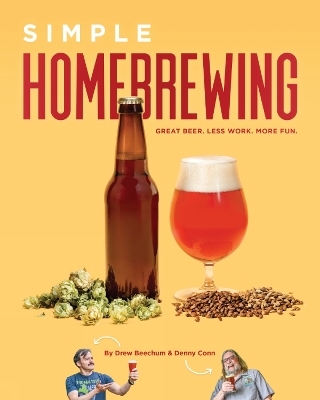
Simple Homebrewing
Brewers Publications (Verlag)
978-1-938469-59-6 (ISBN)
Simple Homebrewing simplifies the complicated steps for making beer and returns brewing to its fundamentals. Explore easy techniques for harnessing water, malted barley, hops, and yeast (along with a few odd co-stars) to create beer. Pick up tips and tricks for a range of brewing challenges like adjusting your brewing liquor, working with adjunct ingredients, controlling fermentation, and brewing wild beers. The authors guide you from extract brewing to all-grain batches and explain the simple philosophy of recipe design and small-batch brewing. Learn how to evaluate different types of malt and hops by tasting, crushing, and steeping them, and use this to build your flavor vocabulary. Denny and Drew also share ideas on how to make technology work for you by taking a look at brewing gadgets, from fancy fermentation jackets and expensive (but convenient) all-in-one “robot” brewing systems, to bucket heaters, swamp coolers and do-it-yourself PID controllers made from inexpensive and commonly available microprocessors.
Drew and Denny’s mantra is “Brew the best beer possible, with the least effort possible, while having the most fun possible.” Throughout, the focus is on helping you develop a simple, thoughtful process to make homebrewing more accessible and enjoyable. Wisdom is imparted in tones both reassuring and amusing, and the basics are broken down into easily remembered chunks. The authors also feature interviews with an eclectic group of brewers from the Americas, who add their own take on the brewing process and how they have made it work for them.
Get a feel for recipe design by looking at a few handy templates for Pilsner, pale ale, IPA, double IPA, stout, tripel, and saison; or try your own bottom-up or top-down approach after reading Denny and Drew’s advice. Along the way you will find over 40 recipes, ranging from the simplest of pale ales, American lagers, tried and tested altbier recipes, and delicious rye IPAs, to Old and New World barleywine, quick tripels, Scotch ale mashed overnight, king cake ale, purple corn beer, and Catherina sour. Marvel at how mushrooms can be used in beer and tremble at the thought of a bourbon barrel–aged barleywine made with ghost pepper. Even experienced homebrewers can learn from this dynamic duo, as Simple Homebrewing features expert advice for brewers of all levels.
Denny Conn brewed his first batch of homebrew in 1998 and has since brewed 500+ more. He is a nationally–ranked Beer Judge Certification Program judge and served on the American Homebrewers Association® Governing Committee for nine years. His homebrew recipes have been brewed by several commercial breweries in both the United States and Europe. Denny was a contributing author to Craft Beer for the Homebrewer and co-authored Experimental Homebrewing and HomeBrew All-Stars with Drew Beechum. He is the co-host of the Experimental Brewing Podcast. He lives in Noti, OR with his wife, five cats, and two dogs. Drew Beechum has been brewing and writing about brewing since he first picked up a kettle in 1999. He is the author of The Everything Homebrewing Book, The Everything Hard Cider Book, and co-authored Experimental Homebrewing and HomeBrew All-Stars with Denny Conn. Drew has also written for Zymurgy® and Beer Advocate magazines, and is co-host of the Experimental Brewing Podcast. He lives in Pasadena, CA, with his lovely wife and loyal army of dogs and cats, and has a dedicated brewery in his home.
TABLE OF CONTENTS
List of Recipes
Acknowledgments
Foreword
Introduction
Chapter 1 – What is Simplicity?
The Inherent Simplicity of Beer
The Importance of a Pragmatic Focus, or A Book's Manifesto in Three Lines
The Efficiency of Simplicity
A Word on Process
But, That's Not How the Pros Do It
What isn't Simplicity?
Profiles in Simplicity: Doug King
Chapter 2 – Simple Extract Brewing
Modern Brewing Pioneers
The Basics about Brewing and Extract
Rescuing Extract from Its Reputation
Why Extract Is Awesome
Why Extract Is Terrible
The Simplest Brew Day Ever
The Oversimplified Explanation of Extract Brewing
What to Expect When You're Expecting Beer
Tricks for the Best Extract Beer
Advanced Extract Brewing
Late Extract
Full-Volume Boil
Use a Chiller
Speed Brewing: Beer in 20 Minutes
How to convert to/from Extract
Other Extract Uses
Yeast Starters
Simplifying Your Brew Day
Boosters
Baking: The Final Frontier
Pretzel Magic
Extract Beer Recipes from Denny
An Inspirational Message to All the Doubters
Profiles in Simplicity: Jay Ankeney
Jay's Tips for Extract Brewing
Chapter 3 – Simple Small Batch
In Defense of Small-Batch Brewing
Less Physical Strength Needed
Smaller Gear and Less Gear
Less Room Needed
More Variety and Experimentation
Less Risk
Less Time Needed
Small Batch Shortcomings
Brewing Small: The Total Picture
A Small-Batch Brew
What's In Your Kitchen?
Brew-in-a-Bag
Small Processes
Profiles in Simplicity: Mary Izett and Chris Cuzme
Chapter 4 – Simple All Grain
The Strict Worlds of Fermentation
It Wasn't Always So
Making Malt
Onto Brewing
Mashing from Start to Finish
The Super High Level Process of Mashing
The Cheap 'n' Easy Mash Tun
Mashing
Working Out Your Mash Water Volume
Batch Sparge
Other Mashing Regimens
Short Mash and Boil
Overnight/Extended Mashing
Brew in a Bag: One-Pot Brewing
Profiles in Simplicity: Chip Walton Teaches Us about Brew-in-a-Bag
Profiles in Simplicity: Jeremy Jalabert—Award-Winning, Busy Dad Brewer
Chapter 5 – Technology Serving Simplicity
Automated Systems
PicoBrew
Brewie+
All–in-One Manual Systems
Grainfather
Speidel Braumeister
Recipe Interlude
Simple Fermentation Systems
BrewJacket Immersion Pro
Vessi Fermentor
Home Canning
Some Assembly Required
Bucket Heaters: A Cheap Electrical Assist
Raspberry Pi and Arduino-Based Systems
Looking into the Crystal Ball
Profiles in Simplicity: Ronaldo Dutra Ferreira
Chapter 6 – Simple Flavor Identification
Simplifying Recipe Design
Understanding Flavors and Ingredients
Flavors in Beer
Understanding Ingredients: Build Your Flavor Database
Malt Evaluation
Malt Evaluation at Home
Hot-Steep Malt Evaluation Method
Hop Evaluation
The Language of Hops
Evaluating Hops at Home
Yeast Evaluation
Clean
Estery and Fruity
Phenolic
Sulfury
Learning Through Drinking
Simple Beer
Chapter 7 – Simple Recipe Design
Evolution of a Homebrewer
Stage 1: Extract Recipe Kits
Stage 2: All-Grain Recipe Kits
Stage 3: Brewing Other People's Recipes
Stage 4: Your Own Recipes
The Philosophy of Recipe Design
Bottom-Up Recipe Design
Top-Down Recipe Design
Every Beer Tells a Story
Single Malt and Single Hop (SMASH)
Choosing Hops
Hop Balancing
Recipe Templates
How Do You Know It Worked?
Triangle Test: The Only Way to Know
Sample Triangle Test Procedure
The Importance of Locality
Profiles in Recipe Design: Randy Mosher
Chapter 8 – Simple Water
Simple Truths About Water
Brewing Water Basics
Treat Your Brewing Water
What's in Your Water?
Understanding Your Water
Calcium
Chloride
Sulfate
Magnesium
Sodium
Chlorine the Killer
Distilled and Reverse Osmosis Water: The Level Playing Field
Adjusting Your Water
pH
Alkalinity
Function and Flavor
Adjusting Your Water: An Example
Is There A Simpler Way?
Sulfate-to-Chloride Ratio
It's Never Too Late
Profiles in Simplicity: Martin Brungard
Chapter 9 – Simple Adjuncts
A Little Adjunct History
How to Adjunct
Adjuncting the Hard Way: Cook 'Em.
Adjuncting the Easy Way
One Final Tip: Hulls are Your Friend
Major Players of the Adjunct World
Wheat
Rye
Oats
Corn
Rice
Potatoes
Sugar
And Now It Gets Weird
Fruit
Vegetables
Not Weird Enough Yet?
Processing the Mushrooms: Denny Experiments
Profiles in Simplicity: Mike Williams of Candi Syrup, Inc.
Chapter 10 – Simple Yeast and Fermentation
Types of Yeast
Ale and Lager Yeast
“Wild” Yeast and Bacteria
Top versus Bottom Fermenting
Yeast Flavors
Ale Yeast: Saccharomyces cerevisiae
Lager Yeast: Saccharomyces pastorianus
Wild Yeast: Brettanomyces Species
Dry or Liquid?
Getting the Yeast Ready to Work
Rehydrating Dry Yeast
Liquid Yeast Starter
Starter by the Numbers
Simplifying the Starter: The Vitality Starter
High-Gravity Fermentations
Fermentation
Why Control Fermentation Temperature?
Easy Methods for Controlling Temperature
Temperature Manipulation
When Is Fermentation Done?
Profiles in Simplicity: Mark Van Ditta
Chapter 11 – Simple Wild
Wild Done Safely
Wild Inoculation
Getting Safer with Booze and Acid
Even Safer with Wild Starters
The Cultured Wild
Kettle Souring: The Ultimate Safe Sour
Blending and Flavoring
Profiles in Simplicity: Garret Garfield
Index
| Erscheinungsdatum | 16.05.2019 |
|---|---|
| Verlagsort | Boulder, CO |
| Sprache | englisch |
| Maße | 203 x 254 mm |
| Gewicht | 513 g |
| Themenwelt | Sachbuch/Ratgeber ► Essen / Trinken ► Getränke |
| ISBN-10 | 1-938469-59-3 / 1938469593 |
| ISBN-13 | 978-1-938469-59-6 / 9781938469596 |
| Zustand | Neuware |
| Haben Sie eine Frage zum Produkt? |
aus dem Bereich


